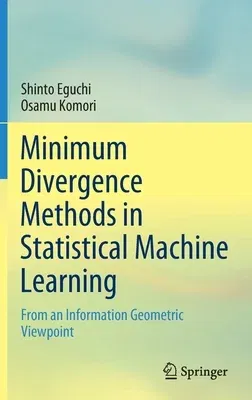This book explores minimum divergence methods of statistical machine
learning for estimation, regression, prediction, and so forth, in which
we engage in information geometry to elucidate their intrinsic
properties of the corresponding loss functions, learning algorithms, and
statistical models. One of the most elementary examples is Gauss's least
squares estimator in a linear regression model, in which the estimator
is given by minimization of the sum of squares between a response vector
and a vector of the linear subspace hulled by explanatory vectors. This
is extended to Fisher's maximum likelihood estimator (MLE) for an
exponential model, in which the estimator is provided by minimization of
the Kullback-Leibler (KL) divergence between a data distribution and a
parametric distribution of the exponential model in an empirical
analogue. Thus, we envisage a geometric interpretation of such
minimization procedures such that a right triangle is kept with
Pythagorean identity in the sense of the KL divergence. This
understanding sublimates a dualistic interplay between a statistical
estimation and model, which requires dual geodesic paths, called
m-geodesic and e-geodesic paths, in a framework of information
geometry.
We extend such a dualistic structure of the MLE and exponential model to
that of the minimum divergence estimator and the maximum entropy model,
which is applied to robust statistics, maximum entropy, density
estimation, principal component analysis, independent component
analysis, regression analysis, manifold learning, boosting algorithm,
clustering, dynamic treatment regimes, and so forth. We consider a
variety of information divergence measures typically including KL
divergence to express departure from one probability distribution to
another. An information divergence is decomposed into the cross-entropy
and the (diagonal) entropy in which the entropy associates with a
generative model as a family of maximum entropy distributions; the cross
entropy associates with a statistical estimation method via minimization
of the empirical analogue based on given data. Thus any statistical
divergence includes an intrinsic object between the generative model and
the estimation method. Typically, KL divergence leads to the exponential
model and the maximum likelihood estimation. It is shown that any
information divergence leads to a Riemannian metric and a pair of the
linear connections in the framework of information geometry.
We focus on a class of information divergence generated by an increasing
and convex function U, called U-divergence. It is shown that any
generator function U generates the U-entropy and U-divergence, in
which there is a dualistic structure between the U-divergence method
and the maximum U-entropy model. We observe that a specific choice of
U leads to a robust statistical procedure via the minimum
U-divergence method. If U is selected as an exponential function,
then the corresponding U-entropy and U-divergence are reduced to the
Boltzmann-Shanon entropy and the KL divergence; the minimum
U-divergence estimator is equivalent to the MLE. For robust supervised
learning to predict a class label we observe that the U-boosting
algorithm performs well for contamination of mislabel examples if U is
appropriately selected. We present such maximal U-entropy and minimum
U-divergence methods, in particular, selecting a power function as U
to provide flexible performance in statistical machine learning.

